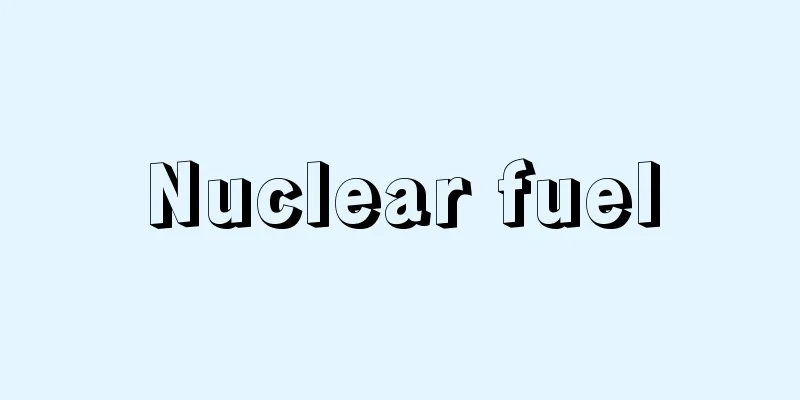Nuclear fuel

|
A component of the reactor core that generates energy through nuclear fission reactions in a nuclear reactor. In addition to fissile materials (uranium U, plutonium Pu), it can also refer to parent materials (such as thorium Th) that produce them by absorbing neutrons. Nuclear fission reactions are, of course, completely different from normal combustion (oxidation reactions), but metaphorical terms such as fuel, combustion, and deadly "ash" (fission products) are used. The nuclides that undergo nuclear fission when neutrons collide can be thought of as being of three types: uranium-235, which is found in about 0.7% of natural uranium; plutonium-239, which is produced by absorbing neutrons into uranium-238, which makes up the majority of natural uranium; and uranium-233, which is produced by absorbing neutrons into thorium-232. The basic structure of a nuclear reactor and the nuclear fuel cycle are determined by the choice of these three fissile isotopes. In that sense, this choice is the basis of nuclear energy policy. Today, light water reactors, which are the most widely used nuclear power reactors, use uranium enriched to about 3% of uranium 235 (low-enriched uranium). Plutonium 239 accumulates in the fuel as it burns in the reactor, but this is separated during reprocessing of the nuclear fuel. Fast neutron reactors, which use high-energy neutrons, use plutonium as fuel, but a blanket filled with fertile material is placed around the core, and neutrons are absorbed by this blanket to produce more plutonium than is consumed. This is called a breeder reactor. If all 1 gram of uranium undergoes nuclear fission, theoretically it would generate energy equivalent to 3 tons of coal. However, since fast breeder reactors have not yet been put into practical use, only about 1% of the uranium is consumed, and in this sense it cannot be said that resources are being used efficiently. There are also attempts to use mixed oxide fuel (MOX fuel = mixed oxide fuel) made of plutonium and low-enriched uranium in light water reactors. In Japan, this is called pluthermal use, as plutonium is used in a thermal reactor, and commercial operation began in 2009. However, the recoverable life of uranium resources increased by pluthermal use is only about 10 years. [Atsushi Tateno] Uranium ResourcesUranium is produced in igneous deposits such as pegmatites and hydrothermal deposits, and sedimentary deposits such as conglomerate and shale deposits, but currently it is mainly mined from the latter, which have larger reserves. According to a 2007 report by the OECD Nuclear Energy Agency (NEA) and the International Atomic Energy Agency (IAEA), the confirmed uranium resources at less than $80 per kilogram are 2.598 million tons, and the estimated resources are 1.858 million tons. Annual production was about 41,000 tons in 2006, and while production in Australia, Canada, Russia, and South Africa has decreased slightly in recent years, it has increased in Kazakhstan and the United States. [Atsushi Tateno] Light water reactor fuel compositionNuclear fuel is required to be stable at high temperatures and have good thermal conductivity. Taking this into consideration, oxide fuel is used in light water reactors. Oxide fuel is uranium dioxide (UO2 ) powder sintered into pellets with a diameter and length of about 1 cm. This is enclosed in a 3.7-meter-long Zircaloy cladding tube, and the top and bottom of the tube are welded and sealed, leaving a plenum for the fission gases. As shown in , in the case of a boiling water reactor (BWR), these fuel rods are arranged in 7 x 7 or 8 x 8 rows and placed in a box-shaped sheath called a channel box, which is called a fuel assembly. Many of these fuel assemblies are gathered together to form the reactor core (about 750 in the case of a 1.1 million kilowatt reactor), and one cruciform control rod (a rod that absorbs neutrons and controls the reactor's power output) is placed for every four assemblies. In the case of a pressurized water reactor (PWR), the number of fuel rods in an assembly is larger (for example, 15 x 15), and the control rods are placed inside the assembly. There is also no channel box. [Atsushi Tateno] Nuclear fuel integrity and reactor safetyAs the burning progresses, fission products accumulate in the fuel pellets, and due to the high temperature (over 2800°C), the center of the pellets melts and cracks appear in the pellets. This deformation of the pellets causes mechanical interaction with the cladding tube, and the corrosion of the cladding tube by the fission products progresses, making the fuel rods more susceptible to damage due to stress corrosion cracking. If the fuel rods are damaged, radioactive materials produced by nuclear fission will be mixed into the cooling water inside the reactor, causing environmental pollution and exposure to workers. In order to prevent fuel damage, it is necessary to avoid operations that involve sudden fluctuations in output. For this reason, with the current level of technology in Japan, it is difficult to operate a power reactor in a load-following manner (an operating method in which electrical output is increased or decreased according to power demand), and constant output operation (base load operation) is unavoidable. [Atsushi Tateno] Nuclear fuel regulationsDomestic regulation of nuclear fuel is carried out based on the Law Concerning the Regulation of Nuclear Source Material, Nuclear Fuel Material and Nuclear Reactors (abbreviated as the Nuclear Reactor Regulation Law, Law No. 166 of 1957). When the law was first enacted, it had a strong emphasis on ensuring safety when using nuclear fuel material, which is a radioactive substance, but as the need for nuclear non-proliferation has been emphasized internationally, provisions related to nuclear non-proliferation have been added. In an international context where the use of plutonium has expanded and the number of countries suspected of possessing nuclear weapons has increased, the focus of regulation has increasingly shifted to the latter since the Nuclear Non-Proliferation Treaty (NPT, also known as the Nuclear Non-Proliferation Treaty) was established in 1970. Specific control methods for preventing nuclear proliferation include safeguards and physical protection of nuclear materials. Safeguards are implemented by the International Atomic Energy Agency (IAEA) based on the Nuclear Non-Proliferation Treaty with the aim of preventing non-nuclear weapon states from covertly diverting nuclear materials intended for peaceful purposes for military use. They require relevant states to conduct accountancy control of nuclear materials, and the IAEA has and exercises the authority to enter facilities and inspect (inspect) whether this is being done properly. This prevents the number of nuclear-weapon states from increasing. On the other hand, physical protection of nuclear material involves setting up protected areas and controlling access and information in order to prevent the theft of nuclear material by terrorists and others from facilities that handle it. Since the facility is physically enclosed, it is called physical protection (PP). Preventing nuclear proliferation (an increase in the number of non-nuclear weapon states) is extremely important, but it has been pointed out that the Nuclear Non-Proliferation Treaty is an unequal treaty that only restricts the possession of nuclear weapons by non-nuclear weapon states, and that in order to truly achieve its goal, it is necessary to eliminate all nuclear weapons, including those held by nuclear weapon states. [Atsushi Tateno] [References] | | | | | |©Shogakukan "> Nuclear fuel assembly for a boiling water reactor (Diagram) Source: Shogakukan Encyclopedia Nipponica About Encyclopedia Nipponica Information | Legend |
|
原子炉内で核分裂反応によってエネルギーを発生させる炉心の構成要素。核分裂性物質(ウランU、プルトニウムPu)とともに、中性子を吸収することによってこれを生み出す親物質(トリウムThなど)をさす場合もある。核分裂反応は、もちろん通常の燃焼(酸化反応)とはまったく異なるが、比喩(ひゆ)的に燃料、燃焼、死の「灰」(核分裂生成物)などということばが用いられている。中性子が衝突して核分裂をおこす核種は、天然ウラン中に約0.7%含まれるウラン235、天然ウランの大部分を占めるウラン238に中性子を吸収させてつくりだすプルトニウム239、およびトリウム232に中性子を吸収させてつくりだすウラン233の3種と考えてよい。この3種類の核分裂性同位元素をどのように選択するかによって原子炉の基本的な構成や核燃料サイクルが定まる。その意味でこの選択は原子力政策の基本となるものである。今日、発電用原子炉としてもっとも多く用いられている軽水炉ではウラン235の含量を3%程度に濃縮したウラン(低濃縮ウラン)を用いる。炉内での燃焼に伴って燃料内にプルトニウム239が蓄積されるが、これは核燃料の再処理に際して分離される。高いエネルギーをもつ中性子を利用する高速中性子炉においては、燃料としてプルトニウムを用いるが、炉心の周囲に親物質を詰めたブランケットを置き、これに中性子を吸収させて消費量以上のプルトニウムを生産することができる。これを増殖炉とよぶ。ウラン1グラムが全部核分裂をおこせば理論的には石炭3トン分に相当するエネルギーを発生する。しかし高速増殖炉が実用化されていない現状ではウランの1%程度が消費されるにすぎず、この意味では資源が有効に利用されているとはいえない。なお、プルトニウムと低濃縮ウランの混合酸化物燃料(MOX燃料=Mixed Oxide Fuel)を、軽水炉で利用する試みもなされている。プルトニウムを熱中性子炉(サーマル・リアクター)で利用することから、日本ではこれをプルサーマル利用とよび、2009年(平成21)から営業運転を開始した。しかし、プルサーマル利用によって増加するウラン資源の可採年数は、10年程度にすぎない。 [舘野 淳] ウラン資源ウランはペグマタイトや熱水鉱床などの火成鉱床および礫岩(れきがん)・頁岩(けつがん)型などの水成鉱床として産出するが、現在では、主として埋蔵量の多い後者から採掘されている。OECD原子力機関(NEA=Nuclear Energy Agency)および国際原子力機関(IAEA)の2007年度資料によると、ウランの確認資源量として、ウラン1キログラム当り80ドル以下のものが259.8万トン、推定資源量として同じく185.8万トンと発表されている。年間の生産量は2006年の数字で4.1万トン程度であり、近年、オーストラリア、カナダ、ロシア、南アフリカ共和国の産出量がやや減少しているのに対して、カザフスタンとアメリカが増大している。 [舘野 淳] 軽水炉燃料の構成核燃料の性質として高温で安定なこと、熱伝導性のよいことが要求されるが、この点を考慮して軽水炉では酸化物燃料が用いられる。酸化物燃料とは、二酸化ウランUO2の粉末を直径、長さとも1センチメートル程度のペレットとして焼結したものである。これを長さ約3.7メートルのジルカロイ製被覆管内に封入し、管の上下は核分裂生成ガスを入れるプレナム部分を残し、溶接密封される。に示すように、沸騰水型原子炉(BWR)の場合は、この燃料棒を7×7本あるいは8×8本配列し、チャネル・ボックスとよぶ箱形の鞘(さや)に収め、これを燃料集合体と名づける。この燃料集合体が多数集まって炉心を形成するが(110万キロワット炉の場合は750個程度)、その際4個の集合体に対して、1個の十字形制御棒(中性子を吸収して原子炉の出力を制御する棒)が配置される。加圧水型原子炉(PWR)の場合、集合体内の燃料棒の数はより多く(たとえば15×15本)、制御棒は集合体内に配置される。またチャネル・ボックスはない。 [舘野 淳] 核燃料の健全性と原子炉の安全燃焼が進むにつれて核分裂生成物が燃料ペレット内に蓄積し、また高温(2800℃以上)のためペレットの中心部は溶融し、ペレット内にはクラックcrackが入る。このようなペレットの変形によって被覆管との間に機械的相互作用が生じ、また核分裂生成物による被覆管の腐食が進行し、応力腐食割れによる燃料棒破損が生じやすい状態となる。燃料棒が破損すれば炉内の冷却水中に核分裂によって生じた放射性物質が混入し、環境汚染や労働者被曝(ひばく)の原因となる。燃料破損を防ぐためには、急激な出力の変動を伴う運転は避ける必要がある。このため現在の日本の技術水準では発電炉の負荷追従運転(電力需要にあわせて電気出力を上下させる運転方式)は困難であり、一定出力の運転(ベース・ロード運転)を余儀なくされている。 [舘野 淳] 核燃料の規制核燃料の国内的な規制は、「核原料物質、核燃料物質及び原子炉の規制に関する法律」(略称「原子炉等規制法」。昭和32年法律第166号)に基づいて行われている。法律の制定された当初は、放射性物質である核燃料物質の利用に際しての、安全確保の色彩が強かったが、その後国際的に核拡散防止の必要性が強調されるにつれて、核拡散防止関連の条項が追加されてきた。プルトニウムの利用が拡大し、また核兵器保有疑惑国が増加する国際情勢の下で、1970年に核不拡散条約(NPT。核拡散防止条約ともいう)が成立してからは、規制の焦点はますます後者に移りつつある。 核拡散防止のための具体的な規制方法としては、保障措置と核物質防護とがある。保障措置とは、非核兵器国が平和利用目的の核物質をひそかに軍事利用に転用することを防止する目的で、国際原子力機関(IAEA)が核不拡散条約に基づいて実施するもので、該当国に核物質の計量管理を義務付け、IAEAは、これが正しく行われているかどうかを、施設に立ち入って検査する(査察)権限を保有し行使する。これによって核保有国が増加することを防止している。 一方、核物質防護とは、核物質の取扱い施設から、テロリストなどによって核物質が盗取されることを防止する目的で、防護区域を設定し、出入管理、情報管理などを行う。物理的に施設を囲い込むので、物理的防護(PP=Physical Protection)とよばれている。 核の拡散(非核兵器国の増加)を防止することは、きわめて重要であるが、上記核不拡散条約は、非核兵器国の核保有のみを制限する不平等条約であり、真に目的を達成するためには、核兵器国の核兵器を含む全ての核兵器の廃絶が必要であることが指摘されている。 [舘野 淳] [参照項目] | | | | | |©Shogakukan"> 沸騰水型原子炉の核燃料集合体〔図〕 出典 小学館 日本大百科全書(ニッポニカ)日本大百科全書(ニッポニカ)について 情報 | 凡例 |
Recommend
《Kissaben》 - Kissaben
…Kashin brought about a breakthrough in the world...
Ararat [mountain] - Ararat
An extinct volcano on the Armenian Plateau, near t...
cable-tool drilling
…In China, bamboo was used instead of wire rope, ...
Missing rice - Kanmai
〘 noun 〙 Additional rice to make up for the loss c...
Kokon Iroha Hyorin - Kokon Iroha Hyorin
A collection of performance critiques on each role...
General and Municipal Workers' Union
...In the UK, the National Insurance Act of 1911 ...
Remote satellite - Enkakueisei
...Considering the ratio of the equatorial radius...
Dazh'bog (English spelling)
… [Origin of the Gods] The Primary Chronicle (als...
All-in-one
A type of underwear or foundation. A combination o...
Matsesta
...There are numerous sanatoriums, health resorts...
Guz - Guz
…the name of an ancient Turkic nomadic people in ...
Nucleophiles - Nucleophiles
They are also called nucleophiles, negative reage...
officer des Marine
... Outside of the United States, the British Roy...
Takikibi - Takikibi
A rather large perennial grass of the grass family...
Whaling ship - Hogeisen (English spelling) Whale catcher
Also called a catcher boat. A fast boat used for c...









